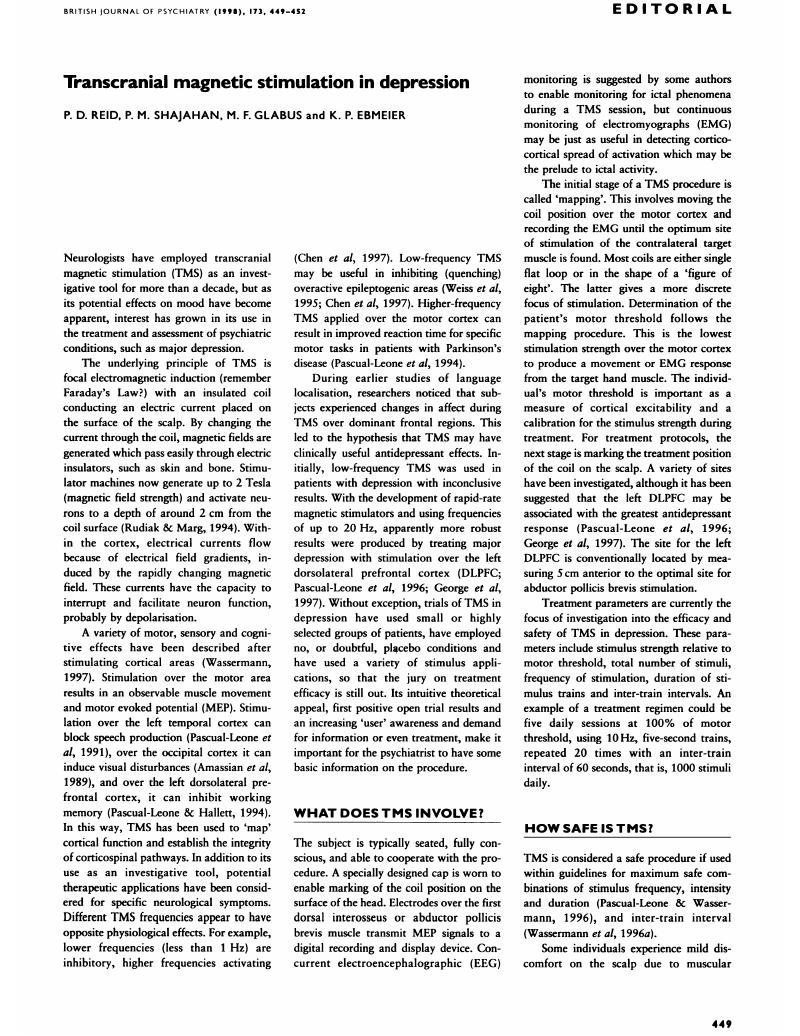Crossref Citations
This article has been cited by the following publications. This list is generated based on data provided by Crossref.
Shimizu, Hiroshi
Tsuda, Takehide
Shiga, Yusei
Miyazawa, Kohichi
Onodera, Yoshiaki
Matsuzaki, Michiko
Nakashima, Ichiro
Furukawa, Katsutoshi
Aoki, Masashi
Kato, Hiroyuki
Yamazaki, Tetsuro
and
Itoyama, Yasuto
1999.
Therapeutic Efficacy of Transcranial Magnetic Stimulation for Hereditary Spinocerebellar Degeneration..
The Tohoku Journal of Experimental Medicine,
Vol. 189,
Issue. 3,
p.
203.
Moore, B.
1999.
Transcranial magnetic stimulation.
British Journal of Psychiatry,
Vol. 174,
Issue. 3,
p.
273.
Doris, Alan
Ebmeier, Klaus
and
Shajahan, Polash
1999.
Depressive illness.
The Lancet,
Vol. 354,
Issue. 9187,
p.
1369.
Garcia-Toro, M.
1999.
Acute manic symptomatology during repetitive transcranial magnetic stimulation in a patient with bipolar depression.
British Journal of Psychiatry,
Vol. 175,
Issue. 5,
p.
491.
Post, Anke
Müller, Marianne B.
Engelmann, Mario
and
Keck, Martin E.
1999.
Repetitive transcranial magnetic stimulation in rats: evidence for a neuroprotective effect in vitro and in vivo.
European Journal of Neuroscience,
Vol. 11,
Issue. 9,
p.
3247.
Zahourek, Rothlyn
2000.
Alternative, Complementary, or Integrative Approaches to Treating Depression.
Journal of the American Psychiatric Nurses Association,
Vol. 6,
Issue. 3,
p.
77.
Alonso, Pino
Pujol, Jesús
Cardoner, Narcís
Benlloch, Luisa
Deus, Joan
Menchón, José M.
Capdevila, Antoni
and
Vallejo, Julio
2001.
Right Prefrontal Repetitive Transcranial Magnetic Stimulation in Obsessive-Compulsive Disorder: A Double-Blind, Placebo-Controlled Study.
American Journal of Psychiatry,
Vol. 158,
Issue. 7,
p.
1143.
Garcia-Toro, Mauro
Mayol, Antoni
Arnillas, Henar
Capllonch, Inmaculada
Ibarra, Olga
Crespı́, Magdalena
Micó, Javier
Lafau, Oriol
and
Lafuente, Laura
2001.
Modest adjunctive benefit with transcranial magnetic stimulation in medication-resistant depression.
Journal of Affective Disorders,
Vol. 64,
Issue. 2-3,
p.
271.
Habel, Ute
Wild, Barbara
Topka, Helge
Kircher, Tilo
Salloum, Jasmin B.
and
Schneider, Frank
2001.
Transcranial magnetic stimulation: no effect on mood with single pulse during learned helplessness.
Progress in Neuro-Psychopharmacology and Biological Psychiatry,
Vol. 25,
Issue. 3,
p.
497.
Young, Allan H
and
Macritchie, Karine AN
2001.
Emerging targets for the treatment of depressive disorder.
Expert Opinion on Therapeutic Targets,
Vol. 5,
Issue. 5,
p.
601.
Garcia-Toro, Mauro
Manuel Montes, Jose
and
Antonio Talavera, Juan
2001.
Functional cerebral asymmetry in affective disorders: new facts contributed by transcranial magnetic stimulation.
Journal of Affective Disorders,
Vol. 66,
Issue. 2-3,
p.
103.
Walter, Garry
Martin, Janine
Kirkby, Kenneth
and
Pridmore, Saxby
2001.
Transcranial Magnetic Stimulation: Experience, Knowledge and Attitudes of Recipients.
Australian & New Zealand Journal of Psychiatry,
Vol. 35,
Issue. 1,
p.
58.
Post, Anke
and
Keck, Martin E.
2001.
Transcranial magnetic stimulation as a therapeutic tool in psychiatry: what do we know about the neurobiological mechanisms?.
Journal of Psychiatric Research,
Vol. 35,
Issue. 4,
p.
193.
Yoshida, Takeshi
Yoshino, Aihide
Kobayashi, Yuji
Inoue, Masayuki
Kamakura, Keiko
and
Nomura, Soichiro
2001.
Effects of slow repetitive transcranial magnetic stimulation on heart rate variability according to power spectrum analysis.
Journal of the Neurological Sciences,
Vol. 184,
Issue. 1,
p.
77.
Pinder, Roger M
2001.
On the feasibility of designing new antidepressants.
Human Psychopharmacology: Clinical and Experimental,
Vol. 16,
Issue. 1,
p.
53.
Gutman, Sharon A.
and
Haynes, Janet L.
2002.
Unipolar Depression.
Occupational Therapy in Mental Health,
Vol. 18,
Issue. 2,
p.
45.
Hong, Byungchul
Kuwaki, Tomoyuki
Ju, Kihwan
Kumada, Mamoru
Akai, Masami
and
Ueno, Shoogo
2002.
Changes in blood pressure and heart rate by repetitive transcranial magnetic stimulation in rats.
Neuroscience Letters,
Vol. 329,
Issue. 1,
p.
57.
Gangitano, Massimo
Valero-Cabré, Antoni
Tormos, José Maria
Mottaghy, Felix Manuel
Romero, Jose Rafael
and
Pascual-Leone, Álvaro
2002.
Modulation of input–output curves by low and high frequency repetitive transcranial magnetic stimulation of the motor cortex.
Clinical Neurophysiology,
Vol. 113,
Issue. 8,
p.
1249.
Aarre, T. F.
Dahl, A. A.
Johansen, J. B.
Kjønniksen, I.
and
Neckelmann, D.
2003.
Efficacy of repetitive transcranial magnetic stimulation in depression: A review of the evidence.
Nordic Journal of Psychiatry,
Vol. 57,
Issue. 3,
p.
227.
Chang, Walter H.
Chang, Kyle T.
and
Li, Jimmy
2003.
Biological Effects of Electromagnetic Fields.
p.
624.




eLetters
No eLetters have been published for this article.